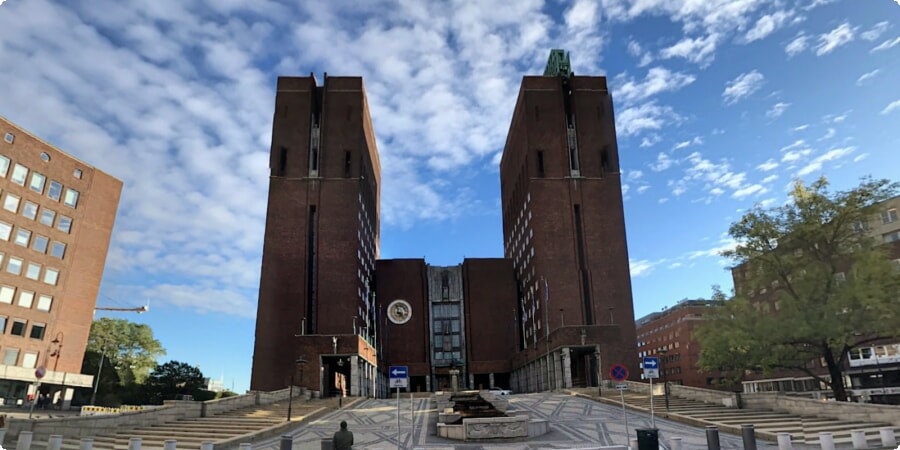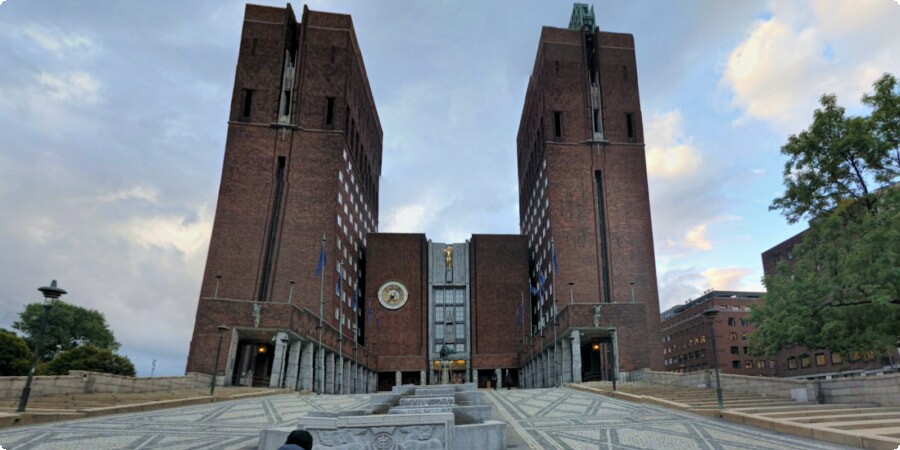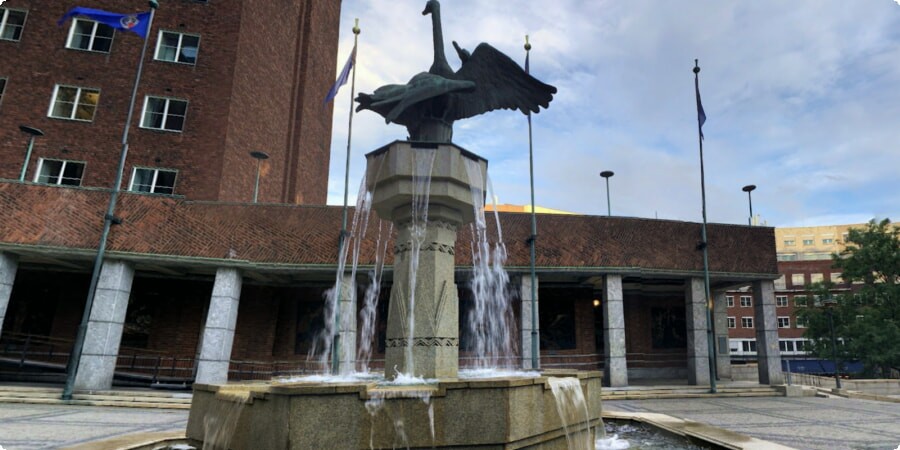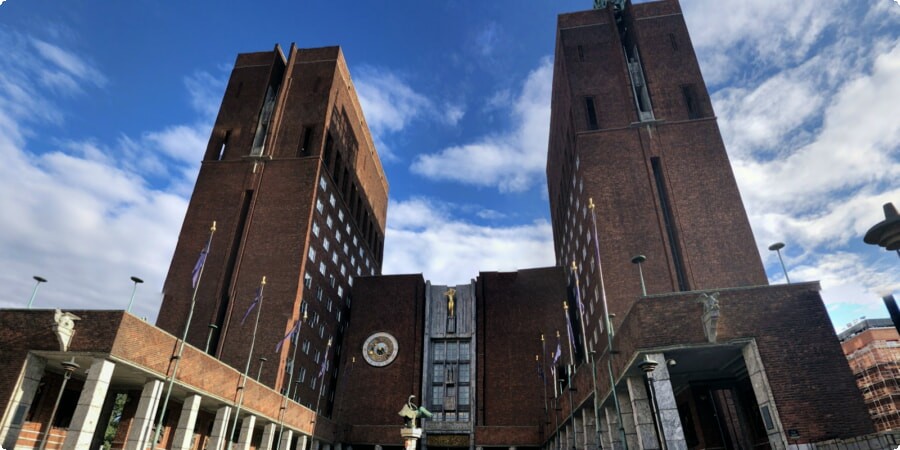Oslo Town Hall: Events, Tours, and Visitor Information
Oslo Town Hall stands as a monumental symbol of Norway's rich history and civic pride. Located in the heart of Oslo, this striking building is not only the seat of the city’s government but also a vital cultural landmark. Completed in 1950, the Town Hall was designed by architects Arnstein Arneberg and Magnus Poulsson in a distinctive, functionalist style that incorporates elements of Norwegian tradition.
The building’s design reflects both its utilitarian purpose and its role as a public space. Its façade, with its robust red brickwork and imposing towers, evokes a sense of stability and permanence. Inside, visitors are greeted by an array of vibrant murals and intricate details that narrate the story of Norway’s history, culture, and values.
Oslo Town Hall is particularly renowned for hosting the Nobel Peace Prize Ceremony annually, a prestigious event that underscores the building’s importance on the global stage. The award, established by Alfred Nobel, is presented here every December 10th, the anniversary of Nobel's death. This ceremony, along with other significant events, highlights the Town Hall’s role as a central hub for both national and international diplomacy.
For a detailed overview of Oslo Town Hall’s history and significance, you can visit its Wikipedia page.
Architectural Highlights
Oslo Town Hall is a masterpiece of mid-20th-century architecture, notable for its blend of traditional Norwegian elements with modernist design. The building’s imposing structure, with its twin towers and expansive public spaces, reflects a design philosophy that emphasizes both grandeur and functionality.
Exterior Design: The Town Hall’s exterior is characterized by its use of red brick, a nod to traditional Norwegian building materials. The brick façade, while robust and utilitarian, is softened by decorative elements, including sculpted reliefs and ornamental details that celebrate Norwegian history and culture.
Interior Features: Inside, the Town Hall is a treasure trove of artistic and architectural marvels. The interiors are adorned with vibrant murals by Norwegian artist Henrik Sørensen, depicting themes ranging from Norwegian folklore to historical events. These murals are not just decorative; they serve as visual narratives that immerse visitors in Norway's rich cultural heritage.

The building's layout includes spacious halls and grand chambers designed to accommodate large gatherings and official functions. Notable spaces include the Main Hall (Storsalen), known for its high ceilings and stunning murals, and the Council Chamber, which features intricate woodwork and rich, warm tones.
The design of Oslo Town Hall reflects a careful balance between aesthetics and function, embodying a vision of civic architecture that serves both as a place of governance and a public monument.
Explore the architectural layout and key features of Oslo Town Hall on Google Maps to get a sense of its impressive scale and design.
Key Events at Oslo Town Hall
Oslo Town Hall is renowned for hosting a range of significant events throughout the year, cementing its role as a central figure in Oslo’s cultural and political life. The building's versatile spaces make it an ideal venue for various types of events, from solemn ceremonies to vibrant public celebrations.
Nobel Peace Prize Ceremony: The most high-profile event held at Oslo Town Hall is the Nobel Peace Prize Ceremony. This prestigious occasion, held every December 10th, commemorates the anniversary of Alfred Nobel's death and honors individuals and organizations that have made significant contributions to peace. The ceremony is attended by international dignitaries and broadcast globally, highlighting the Town Hall’s role on the world stage.
Civic Ceremonies and Receptions: In addition to the Nobel Peace Prize, Oslo Town Hall hosts numerous civic ceremonies, including awards presentations, official receptions, and cultural events. These gatherings reflect the building’s role as a hub of Oslo’s public life and its importance in Norwegian society.
Cultural Events and Exhibitions: The Town Hall also serves as a venue for various cultural events, including art exhibitions and musical performances. These events often feature works by local artists and provide opportunities for the public to engage with Norwegian culture in a historic setting.

Public Tours and Educational Programs: The Town Hall offers guided tours that allow visitors to explore its architectural and artistic features. These tours provide insights into the building’s history, the significance of its artworks, and the events it hosts. Educational programs and workshops are also available, making the Town Hall a vibrant center for learning and cultural exchange.
To fully experience the richness of Oslo and its surrounding attractions, renting a car is a convenient option. You can book a car at Oslo Airport through this link for a flexible and enjoyable travel experience.
Guided Tours and Visitor Experiences
Oslo Town Hall offers a range of guided tours that provide an in-depth look at this iconic building’s architecture, history, and cultural significance. These tours are an excellent way to enhance your visit, offering insights into both the building's design and its role in Norwegian society.
Tour Options: The Town Hall provides several types of tours to accommodate different interests and schedules:
- Standard Guided Tours: These tours cover the main highlights of the Town Hall, including the architectural features and notable artworks. Guides offer engaging commentary on the building’s history and significance.
- Themed Tours: For those interested in specific aspects of the Town Hall, themed tours focus on particular elements such as the Nobel Peace Prize Ceremony or the murals and sculptures.
- Private Tours: Private tours can be arranged for a more personalized experience. These tours are ideal for groups or individuals who wish to explore the Town Hall at their own pace with a dedicated guide.
Booking and Availability: Tours are available throughout the week, with schedules varying depending on the season. It is advisable to book your tour in advance to secure your preferred time slot. Information on booking can be found on the official Oslo Town Hall website.
Accessibility: The Town Hall is committed to providing an accessible experience for all visitors. Wheelchair access is available, and tours can be adapted to accommodate special needs. It’s recommended to inform the booking staff of any specific requirements when arranging your visit.
For a seamless visit, consider renting a car in Norway to explore Oslo and the surrounding areas. Booking a car can enhance your travel experience and provide flexibility. You can reserve a vehicle through this link.

Exploring the Art and Murals
One of the most compelling aspects of Oslo Town Hall is its collection of art, including murals and sculptures that adorn its walls and spaces. These artworks are integral to the building’s identity, reflecting Norway’s cultural heritage and artistic achievements.
Murals and Artworks: The Town Hall’s interiors are decorated with stunning murals by Norwegian artist Henrik Sørensen and others. These murals, painted in the 1950s, cover themes ranging from Norwegian history to social values:
- Main Hall Murals: The Main Hall features large murals depicting scenes from Norwegian life and history. These artworks are celebrated for their vibrant colors and detailed storytelling, offering visitors a glimpse into Norway’s past and present.
- Council Chamber Art: The Council Chamber showcases intricate woodwork and a series of murals that highlight Norwegian cultural symbols and national pride. The artwork in this space complements the chamber’s elegant design.
Symbolism and Interpretation: Each piece of art within Oslo Town Hall carries deep symbolic meaning. The murals are designed not just for aesthetic appeal but to provoke thought and reflection on important themes such as democracy, peace, and unity. Guided tours often provide detailed explanations of the symbolism behind the artworks, enriching your understanding of their significance.
Notable Artists: Henrik Sørensen, one of Norway’s most prominent muralists, was responsible for many of the murals in the Town Hall. His work is renowned for its emotional depth and historical accuracy, making it a focal point of any visit.
Visitor Information
When planning a visit to Oslo Town Hall, having accurate and comprehensive information can help ensure a smooth and enjoyable experience. Here’s everything you need to know to make the most of your trip:
Opening Hours: Oslo Town Hall is open to visitors daily. The standard visiting hours are typically from 9:00 AM to 5:00 PM, but these may vary depending on the season and special events. It is always a good idea to check the latest opening times on the official website before your visit.
Admission Fees: Admission to Oslo Town Hall is free of charge, making it an accessible destination for all visitors. Special events or exhibitions may have separate fees, so it’s worth checking ahead if you plan to attend these.

Getting There: The Town Hall is centrally located in Oslo, making it easily accessible by public transportation. Trams, buses, and trains all connect to the area, with the nearest public transport stops located within walking distance. For those driving, there are parking options available nearby.
Facilities: The Town Hall is equipped with amenities to enhance your visit, including restrooms, a café, and a gift shop. The café offers a selection of snacks and beverages, providing a convenient place to relax during your visit.
Nearby Attractions: After exploring Oslo Town Hall, consider visiting nearby attractions such as the Oslo Opera House, the Royal Palace, or the Aker Brygge waterfront. These sites offer additional cultural and recreational opportunities.
For a comfortable and flexible travel experience, consider renting a car. Having your own vehicle allows you to explore Oslo and beyond at your own pace. You can book a car rental through this link for a convenient and hassle-free option.
Events and Booking Information
Oslo Town Hall is a vibrant venue that hosts a variety of events throughout the year. From prestigious ceremonies to cultural exhibitions, the building’s versatile spaces accommodate a wide range of activities, making it a focal point of Oslo’s public and cultural life.
Booking Events: If you're interested in attending an event at Oslo Town Hall, it's important to plan ahead. The Nobel Peace Prize Ceremony, in particular, is a high-profile event that attracts international attention, so securing your place early is crucial. Tickets for this event are generally distributed through a lottery system, and details are usually announced several months in advance.
Special Events and Private Functions: For those looking to host an event, Oslo Town Hall offers the opportunity to book spaces for private functions, including conferences, receptions, and banquets. These bookings can be made by contacting the Town Hall’s events team through their official website. The team can assist with arrangements and provide information on available facilities, catering options, and technical support.
Public Events: In addition to private functions, the Town Hall hosts a range of public events such as art exhibitions, concerts, and lectures. To stay informed about upcoming events, regularly check the Town Hall’s website and local event listings. Many events are free of charge, offering a great way to experience the cultural vibrancy of Oslo.
Tips for a Memorable Visit
To make the most of your visit to Oslo Town Hall, consider these practical tips and recommendations:
Best Times to Visit: The Town Hall is popular with tourists, especially during peak travel seasons. For a more relaxed experience, aim to visit during the morning or early afternoon on weekdays. Avoid weekends and public holidays if you prefer to avoid larger crowds.
Exploring the Surroundings: Oslo Town Hall is located in a bustling area with plenty to see and do. Take the time to explore the nearby attractions, such as the Oslo Opera House and the waterfront area of Aker Brygge. These locations offer additional sightseeing opportunities and dining options.
Photography Tips: Photography is generally allowed inside the Town Hall, but it’s important to be respectful of guided tours and other visitors. For the best shots of the murals and architectural details, use a camera with good lighting capabilities. Flash photography is not permitted in certain areas to protect the artworks.
Dining and Refreshments: The Town Hall features a café where you can enjoy a variety of refreshments. However, if you’re looking for a wider selection of dining options, consider exploring the nearby restaurants and cafes in the Aker Brygge area. This waterfront district is known for its diverse culinary scene and beautiful views.
Accessibility Considerations: The Town Hall is accessible to visitors with disabilities. If you have specific needs, such as wheelchair access or assistance with navigating the building, inform the staff in advance to ensure your visit is comfortable.
Local Travel and Parking: If you’re driving to the Town Hall, be aware that parking can be limited in the city center. Utilizing public transportation or renting a car can provide flexibility in exploring Oslo. For car rentals, consider booking through this link to secure a convenient option for your trip.
Oslo Town Hall: A Testament to Civic Pride and Cultural Heritage
Oslo Town Hall stands as a testament to Norway’s dedication to preserving its civic pride and cultural heritage. Its distinctive architecture and rich history make it a landmark worth exploring.
The building’s design reflects a commitment to both functional civic space and artistic expression, offering visitors a glimpse into Norway’s values and history. From its iconic murals and architectural grandeur to its role in hosting the Nobel Peace Prize Ceremony, Oslo Town Hall plays a crucial role in Oslo’s cultural and civic landscape.
Whether you’re interested in attending an event, exploring its art, or simply appreciating its architectural beauty, Oslo Town Hall offers a wealth of experiences. Plan your visit to include a guided tour, take advantage of the various cultural events, and immerse yourself in the history that this remarkable building represents.
As you explore Oslo Town Hall, you’ll discover that it is more than just a government building; it’s a vibrant center for culture, history, and public engagement.